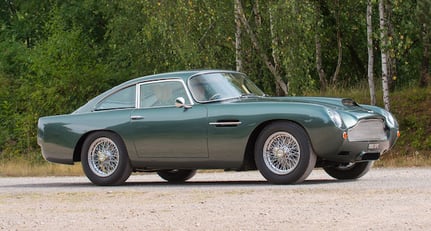1960 Aston Martin DB4
-
Baujahr1960
-
ChassisnummerDB4/513/R
-
Losnummer250
-
LenkungLenkung links
-
ZustandGebraucht
-
Zahl der Sitze2
-
Standort

-
AußenfarbeSonstige
-
Antrieb2wd
-
KraftstoffPetrol
Beschreibung
1960 Aston Martin DB4 to GT Specification
Registration no. 990 SPE
Chassis no. DB4/513/R
The competition potential of Aston Martin's new DB4 had been recognised from the outset, and the factory lost no time in developing a lightweight version suitable for racing, the resulting DB4 GT debuting at the 1959 London Motor Show. The model had already been proven in competition earlier that year when the prototype ('DP/199') driven by Stirling Moss won its first race at Silverstone. Extensive modifications to the standard car took 5" (127mm) out of the wheelbase, and replaced the rear seats with a luggage platform on all but a small number of cars. Together with lighter, 18-gauge bodywork, these changes reduced the car's weight by around 200lb (91kg).
The GT used a tuned engine which, equipped with a twin-plug cylinder head and triple Weber 45DCOE carburettors, produced a claimed 302bhp at 6,000rpm, a useful increase over the standard car's claimed 240bhp. Maximum speed, of course, depended on overall gearing, but 153mph was achieved during testing with a 0-60mph time of 6.1 seconds recorded. The DB4 was also one of the first cars to go from standstill to 100mph and then brake to a dead stop on under 20 seconds, a tribute, in part, to its up-rated Girling brakes as used on Aston Martin's competition sports racers of the era.
Viewed from the front, the GT was readily distinguishable by its faired-in headlamps with Perspex covers, a feature later made standard on the DB5 and DB6. The rear screen and quarter windows were made of Perspex on many examples; bumper over-riders were deleted and the wind-down windows were frame-less within the doors. Twin, quick-release, Monza competition fuel fillers were added atop the rear wings, leading to a large-capacity fuel tank mounted flat in the boot. GTs were fitted as standard with lightweight Borrani 42-spoke wire wheels with alloy rims and 3-ear 'knock-offs'. The interior was trimmed to full Aston Martin road car specification, with fine Connolly leather upholstery and deep-pile Wilton carpeting. The evocative instrument binnacle on the GT benefited from the addition of an oil temperature gauge to the standard array.
DB4 GTs offered a strong challenge to the prevailing Ferrari dominance in GT racing, examples entered by the works and John Ogier's Essex Racing Stable enjoying numerous victories. Driven by the likes of Roy Salvadori, Stirling Moss, Jim Clark and Innes Ireland, the DB4 GT earned its stripes every day on the racing circuit. In December 1959, at the Bahamas Speed Week, Stirling Moss won driving a standard customer DB4 GT 'borrowed' back by the works following the demise of Moss's intended DBR2! The DB4 GT was indeed a true dual-purpose car, equally at ease on both the circuit and Grand Tour. Only 75 'Sanction 1' DB4 GTs were produced between 1959 and 1963 plus 19 of the DB4 GT Zagato.
This stunning re-creation of one of Aston Martin's most iconic models started life as a standard DB4 Series 2. The current owner purchased the car in 'barn find' condition and commissioned marque specialists Chris Shenton Engineering to carry out a 'no-expense-spared' restoration. However, this was to be no ordinary restoration, for the project was to incorporate a number of significant developments and ideas to create a unique and interesting motor car.
The first task was to dismantle the vehicle completely; the chassis was then fixed to a jig and shortened by 5" to DB4 GT specification. Any corroded metalwork was cut out and new panels made and fitted as required. The chassis was then completely re-coated in red oxide and under-sealed. New aluminium panels were made for the bodywork, and once completed a new 30-gallon alloy fuel tank was made to the exact DB4 GT specification. The entire car was then painted in the familiar DB4 GT colour 'Aston Racing Green', and a special interior fitted and trimmed in best Connolly leather and Wilton carpeting. A new correct-type dashboard was made to house the correct DB4 GT instrumentation (sourced at great expense).
While this considerable restoration and transformational work was ongoing, the owner and his restorer discussed the possibility of developing and fitting independent rear suspension that would be located in the original fixing points (a conversion that designer Harold Beach had always wanted).
The conversion consisted of proven and well-known components engineered to form an independent rear suspension assembly mounted on a sub-frame. This form of installation would allow the standard axle to be removed and the independent assembly fitted onto the same locating points, without having to change or modify the original structure. Thus, the conversion could easily be removed at any stage and the suspension returned to standard if desired. The benefits of this up-rating are dramatically improved road holding, handling, and ride comfort; moreover, with a significantly up-rated engine being planned, it was felt it was the only way of coping with the expected substantial increase in power! Changes were also made to the front suspension to match, while new enlarged brakes were fitted to complement the projected additional power and available grip, consisting of special callipers/discs and a special handbrake cable installation, etc.
Turning to the engine, it had been agreed that it would be appropriate for '990 SPE' to be fitted with an exciting upgrade - to 4.7 litres! As the car was now in effect a DB4 GT with IRS, it was decided that the engine conversion should include a new twin-plug cylinder head casting to correct DB4 GT specification, together with new crankshaft, Cosworth pistons, Carrillo rods, etc. The engine has a compression ratio of 9.1.1 and has been set-up to run on premium unleaded fuel. Reassembled, the engine was connected to the dynamometer, recording the outstanding figures of 341bhp at 5,500rpm and 323ft/lbs of torque. It was then reinstalled and mated to a five-speed gearbox.
After six years work, this unique blend of chassis, engine, IRS, and brakes has resulted in a most effective and exciting DB4 GT that is equally at home as a fast road/rally car or gracing the concours lawns. Chris Shenton Engineering are justifiably proud of this amazing motor car; when recently road tested, both drivers came back with smiles all round and both agreed that one word summed it up: 'Superb!' The owner is reluctantly selling only to fund an exciting new project.
Beautifully presented, this motor car is indistinguishable from any of the 75 DB4 GTs originally produced, and outperforms, out-brakes, handles better, and looks better than an original that would command a price exceeding £2 million. It comes complete with current V5 (matching numbers); current MoT; a 65-page fully detailed invoice; build sheet; dynamometer printout; a full photographic record of the restoration; and restorer's warranty.
With all the surviving genuine DB4 GTs either in museums or private collections, this stunning re-creation represents a wonderful opportunity to acquire a car built in the spirit of the original at a fraction of the cost.


























